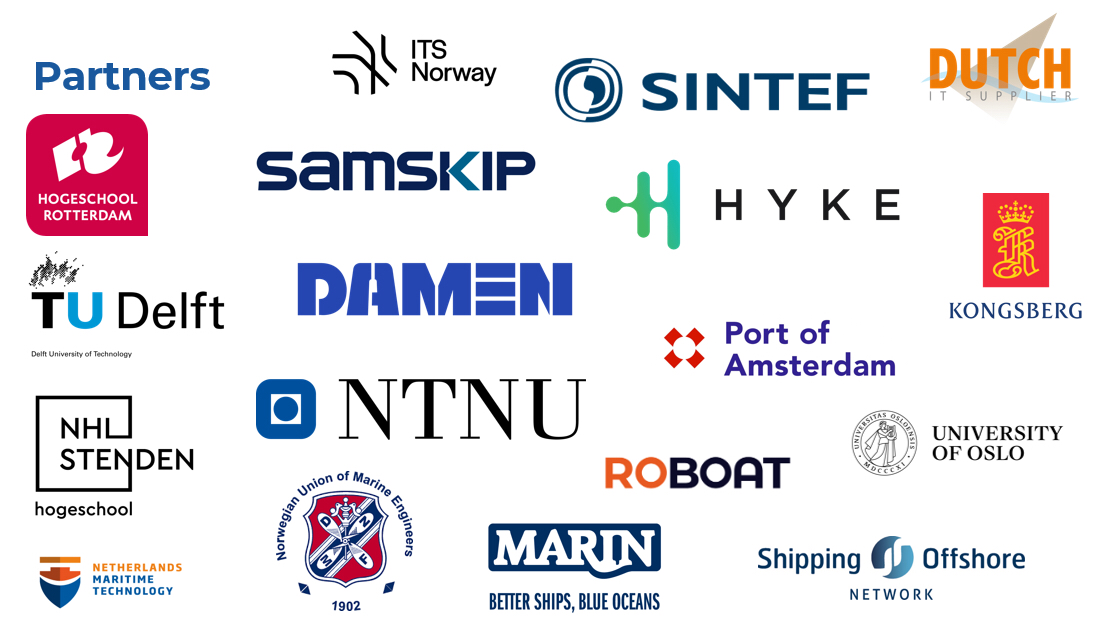MIIP008 Green and autonomous corridor
Project proposal summary
During the study trip from SMASH to Norway, the Norwegian and Dutch Smart Shipping communities have raised the prospect of establishing a Green & Autonomous Corridor between the Netherlands and Norway. This corridor would be characterized by sustainable energy consumption through optimized ship usage, reduced sailing speeds, autonomous navigation, docking, and manoeuvring, as well as a shift from road to water transportation—a true embodiment of environmentally conscious maritime practices.
Autonomous navigation in this corridor introduces complex technological, legal, and economic challenges. These challenges are more pronounced than those faced in autonomous sailing within fjords or inland shipping, attributed to a wider range of weather conditions, heightened maritime traffic, and spatial constraints due to wind farm development. The prospect of multi-day sea journeys, differing from the conventional hours-long fjord trips, is also under discussion. The international character of the route further complicates the application of autonomy. Discussions within the International Maritime Organization (IMO) revolve around the prerequisites for future autonomous sailing. Nevertheless, the regulatory process is expected to extend across several years and necessitates insights from experimental initiatives.
The conditions for initiating experiments and the roles of countries, flag states, and the business community remain uncertain. Another aspect is the driving force compelling businesses to invest in Green & Autonomous concepts.
The core aim of the MIIP project is to explore the viability and benefits of establishing a Green & Autonomous Corridor connecting Norway and the Netherlands. This corridor would serve as a platform for the logistics sector, technology providers, research institutions, and governments to conduct experiments and gain insights into the secure implementation of advanced automation within the intricate operational landscape of the North Sea. The desired outcome includes formulating a research agenda and presenting a proposal for a dynamic living lab, facilitating research and experimentation activities.
Approach
In this project, five different perspectives are specified:
GAC Business cases WP1) – Overview of the benefits (monetary, security and sustainability dimensions) and the extent to which these can be achieved for various progressive automation steps for ships that routes within the Green Autonomous Corridor.
Complexity and required technology (WP2) – Elaboration of the specific technical, communicative and organizational challenges that must be met when sailing in ports and on the North Sea,
Legal framework (WP3) – Overview of legal restrictions associated with experimenting or working with increasing levels of automation, and all involved stakeholders as needed for exemptions, alternate approvals or updated legislation.
Safety case & methodology (WP4) – elaboration of the preconditions, structure and recommended methodology for a safety case analysis for the corridor, taking into account conditions of the relevant regulatory stakeholders.
Living lab (WP5) – Setting up a living lab, taking into account the technical requirements, the legal framework and a manageable governance model and targeted scalability inside and outside the corridor (multiple technology parties, multiple ships, multiple operators).
The research is based on existing studies and reports from various previous projects and initiatives. In the project, a state-of-the-art overview of relevant knowledge and a translation to apply to the corridor to overcome the challenges and create a white spot appoint. No new research will be carried out within this MIIP project in the field of technology, business case, or legal framework; it’s about contextualising previous studies.
Each work package starts with a problem statement elaborated by the initiator of the work package. This is coordinated with all participants in a kick-off work package. A literature scan is performed based on the problem statement executed. The most important insights are summarized and discussed in the working group of the work package to arrive at an initial elaboration for the corridor. Subsequently, all project partners present in writing and workshops what their vision and needs are in solving the problem. The last step will be held in a workshop with the project partner and external stakeholders to determine which research questions must be answered in order to construct the corridor and what preconditions must be created in order to achieve this development and research.
Milestones:
Establish Terms of Reference for WP2-5 – June 2023
Substantive completion of WP 2,3,4 (input for WP5, living lab) – Nov 2023
Substantive completion WP5 living lab – Jan 2024
Delivery of substantive reports – Feb 2024
Partners
We are delighted to introduce our project partners. Through this diverse coalition of contributors, we guarantee an outcome that encompasses insights from all pertinent stakeholders, containing Norwegian and Dutch entities, knowledge institutions and commercial parties, shipowners and technology providers and many more.
- Hogeschool Rotterdam
- Delft University of Technology
- NHL Stenden Hogeschool
- Netherlands Maritime Technology
- ITS Norway
- Samskip
- Damen
- Norwegian University of Science and Technology
- Norwegian Union of Marine Engineers
- Marin
- Sintef
- Hyke
- Kongsberg
- Shipping Offshore Network
- University of Oslo
- Roboat
- Port of Amsterdam
- Dutch IT Supplier
Are you interested in participating in this project and shaping the future of autonomous shipping? Or would you like to stay informed? Feel free to reach out. Let’s collaborate and unleash the full potential of autonomous shipping together!
